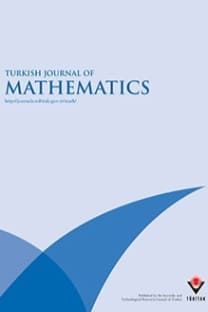On the chromatic polynomial and the domination number of k-Fibonacci cubes
On the chromatic polynomial and the domination number of k-Fibonacci cubes
___
- [1] Azarija J, Klavžar S, Rho Y, Sim S. On domination-type invariants of Fibonacci cubes and hypercubes. Ars Mathematica Contemporanea 2018; 14: 387-395. doi: 10.26493/1855-3974.1172.bae
- [2] Castro A, Klavžar S, Mollard M, Rho Y. On the domination number and the 2-packing number of Fibonacci cubes and Lucas cubes. Computers & Mathematics with Applications 2011; 61: 2655-2660. doi: 10.1016/j.camwa.2011.03.012
- [3] Egiazarian K, Astola J. On generalized Fibonacci cubes and unitary transforms. Applicable Algebra in Engineering, Communication and Computing 1997; 8: 371-377. doi: 10.1007/s002000050074
- [4] Eğecioğlu Ö, Saygı E, Saygı Z. k -Fibonacci cubes: A family of subgraphs of Fibonacci cubes. International Journal of Foundations of Computer Science 2020; 31 (5): 639-661. doi: 10.1142/S0129054120500318
- [5] Hsu WJ. Fibonacci cubes – a new interconnection technology. IEEE Transactions on Parallel and Distributed Systems 1993; 4: 3-12. doi: 10.1109/71.205649
- [6] Ilić A, Milošević M. The parameters of Fibonacci and Lucas cubes. Ars Mathematica Contemporanea 2017; 12; 25-29. doi: 10.26493/1855-3974.915.f48
- [7] Ilić A, Klavžar S, Rho Y. Generalized Fibonacci cubes. Discrete Mathematics 2012; 312: 2-11. doi: 10.1016/j.disc.2011.02.015
- [8] Klavžar S. Structure of Fibonacci cubes: a survey. Journal of Combinatorial Optimization; 25: 505-522. doi: 10.1007/s10878-011-9433-z
- [9] Klavžar S, Mollard M. Cube polynomial of Fibonacci and Lucas cube. Acta Applicandae Mathematicae 2012; 117: 93-105. doi: 10.1007/s10440-011-9652-4
- [10] Klavžar S, Mollard M. Daisy cubes and distance cube polynomial. European Journal of Combinatorics 2019; 80: 214-223. doi: 10.1016/j.ejc.2018.02.019
- [11] Mollard M. Non covered vertices in Fibonacci cubes by a maximum set of disjoint hypercubes. Discrete Applied Mathematics 2017; 219: 219-221. doi: 10.1016/j.dam.2016.10.029
- [12] Munarini E. Pell graphs. Discrete Mathematics 2019; 342 (8): 2415-2428. doi: 10.1016/j.disc.2019.05.008
- [13] Munarini E, Cippo CP, Zagaglia Salvi N. On the Lucas cubes. Fibonacci Quarterly 2001; 39: 12-21.
- [14] Pike DA, Zou Y. The domination number of Fibonacci cubes. Journal of Combinatorial Mathematics and Combinatorial Computing 2012; 80: 433-444.
- [15] Saygı E. Upper bounds on the domination and total domination number of Fibonacci cubes. SDU Journal of Natural and Applied Sciences; 21 (3): 782-785. doi: 10.19113/sdufbed.05851
- [16] Saygı E. On the domination number and the total domination number of Fibonacci cubes. Ars Mathematica Contemporanea 2019; 16: 245-255. doi: 10.26493/1855-3974.1591.92e
- [17] Saygı E, Eğecioğlu Ö. Counting disjoint hypercubes in Fibonacci cubes. Discrete Applied Mathematics 2016; 215: 231-237. doi: 10.1016/j.dam.2016.07.004
- [18] Saygı E, Eğecioğlu Ö. q -cube enumerator polynomial of Fibonacci cubes. Discrete Applied Mathematics 2017; 226: 127-137. doi:10.1016/j.dam.2017.04.026
- [19] Saygı E, Eğecioğlu Ö. Boundary enumerator polynomial of hypercubes in Fibonacci cubes. Discrete Applied Mathematics 2019; 266: 191-199. doi: 10.1016/j.dam.2018.05.015
- [20] Taranenko A. Daisy cubes: a characterization and a generalization. European Journal of Combinatorics 2020; 85: 103058. doi: 10.1016/j.ejc.2019.103058
- ISSN: 1300-0098
- Yayın Aralığı: 6
- Yayıncı: TÜBİTAK
Some higher-order identities for generalized bi-periodic Horadam sequences
Benedicks and Donoho-Stark type theorems
On Hausdorff-Young inequalities in generalized Lebesgue spaces
Application of spectral mapping method to Dirac operator
On the autocentralizer subgroups of finite p–groups
Parisa SEIFIZADEH, AmirAli FAROKHNIAEE, Ali GHOLAMIAN, Mohammad Mehdi NASRABADI
Some results on top generalized local cohomology modules with respect to a system of ideals
On X -Gorenstein projective dimensions and precovers
Dynamics of a fluid equation with Neumann boundary conditions
